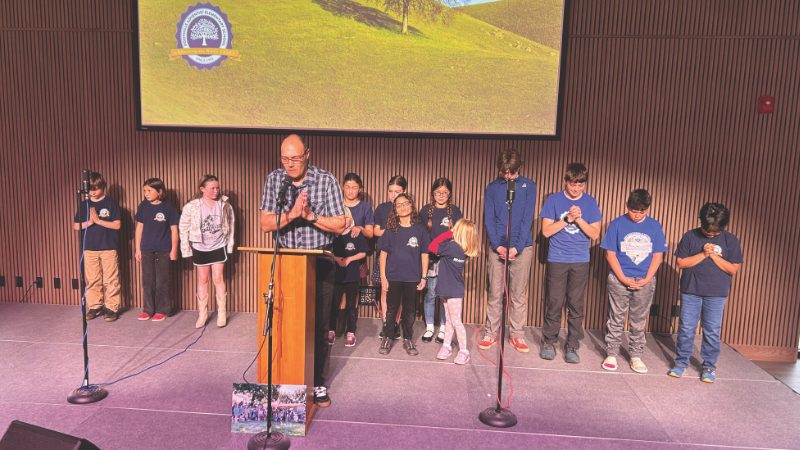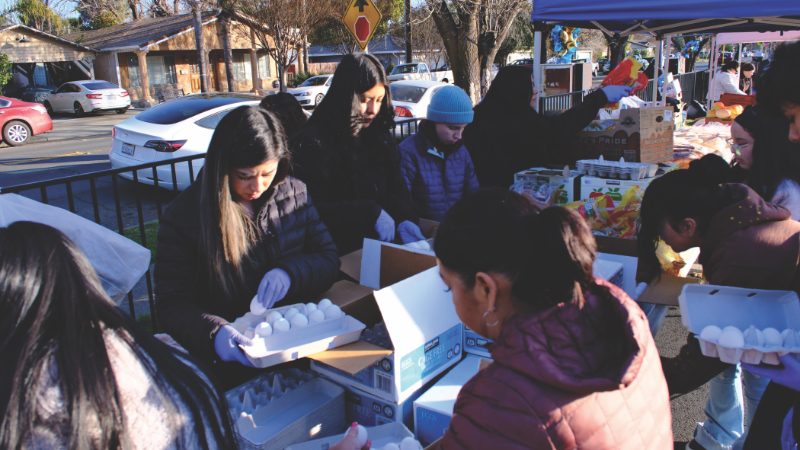By the Recorder editorial staff
Early days in Los Angeles

With most early Adventist activity concentrated in the northern part of the state, it wasn’t until 1874 that Southern California had an ordained minister in its territory—John B. Judson. Evangelism picked up with the arrival of William Healey, who held a series of tent meetings in downtown Los Angeles in 1879. This laid the foundations for the first Adventist church in Southern California, which after a couple of moves became known as the Central church.
These were small beginnings. E.J. Waggoner refers to “the little company at Los Angeles” in an article in the Signs of the Times of May 29, 1884.
However, a second church group was organized in Norwalk later that year, and it was the first to construct a church building. Later, other churches were built in Los Angeles, San Pedro, and Pasadena.
Other approaches to evangelism were also tried. In 1896, a vegetarian restaurant opened, together with medical treatment rooms under the direction of Dr. Moran. These were located between Broadway and Hill on Third Street in Los Angeles. In addition to the group of about 100 that met at the Carr Street church, another group had come together on the east side of Los Angeles, later becoming the Lincoln Park church.
When Merritt G. Kellogg left St. Helena Sanitarium in 1889, he moved to El Monte. He discovered that there were two members there and that in Pomona there was a group of 16—who in 1886 had attended tent meetings conducted by E.A. Briggs, a blind Adventist evangelist.
A separate Southern California Conference
Up until this time, everything was under the direction of the California Conference, based in Oakland. At a camp meeting held there in 1901, it was decided to form a separate Southern California Conference, made up of the area of the state south of the Tehachapi and Santa Ynez mountains.
The new conference had four ordained and six licensed ministers, 19 churches and two unorganized companies, a membership of 1,200, and 11 church schools.
The church schools were very much part of the church’s mission. The church school begun in 1898 in Centralia, southeast of Los Angeles, was followed in 1902 by schools conducted in Santa Ana, Pasadena, Norwalk, at the Carr Street church in Los Angeles, and in other cities. The school at San Fernando also began in 1902.
William Ward Simpson
But the big impact on Los Angeles came with the arrival of William Ward Simpson in 1904. He had previously held successful meetings in Redlands, Riverside, Pasadena, San Diego, and San Francisco, but now he turned his attention to the metropolis of Los Angeles. Simpson was probably the most successful evangelist of the time, and he was particularly effective in the cities. His creative style and intriguing presentations captured the interest of many, so that his tent meetings reached some 2,000 in attendance. More than 200 baptisms were the immediate result.
This success caught the attention of church leaders, particularly Ellen White. She wrote several letters to Simpson, encouraging him and suggesting that others adopt similar methods. For example: “I am deeply interested in your work in Southern California. I am so anxious that you shall not break down under the strain of long, continuous effort. Let someone connect with you who can share your burdens” (Ellen G. White, “Proper Voice Culture,” Manuscript Releases, vol. 9, p. 15).

She wrote about him to others:
Brother S is an intelligent evangelist. He speaks with the simplicity of a child. Never does he bring any slur into his discourses. He preaches directly from the Word, letting the Word speak to all classes. His strong arguments are the words of the Old and the New Testaments. He does not seek for words that would merely impress the people with his learning, but he endeavors to let the Word of God speak to them directly in clear, distinct utterance.…
I am pleased with the manner in which our brother [Elder Simpson] has used his ingenuity and tact in providing suitable illustrations for the subjects presented—representations that have a convincing power. Such methods will be used more and more in this closing work” (Ellen G. White, Evangelism, pp. 204-205).

I am deeply interested in your work in Southern California. I am so anxious that you shall not break down under the strain of long, continuous effort.

In fact, Ellen White was so interested that she came in person to support him. “For some time Elder Simpson has been holding tent meetings in a large tent, which is pitched near the business part of the city. On Sabbath morning I spoke in this tent. Notice had been sent to the churches near Los Angeles, and there were about a thousand people present” (Ellen G. White, “Encouraging Letter From California,” The Southern Missionary, Dec. 1, 1904).

When it was suggested that he move to a different location, he received a petition signed by many people asking him to stay for another evangelistic series. Ellen White also thought a move was a bad idea, and she advised he should stay where he was (Ellen G. White, “Counsel Relating to the Work in Los Angeles and the Paradise Valley Sanitarium,” Manuscript Releases, vol. 15, p. 314).
The tragedy was that by 1907 Simpson was dead at the age of 34, leaving behind a wife and three young children. Other evangelists took over, such as Luther Warren from 1908 to 1910, J.W. McCord, Fred Paap, Milton St. John, E.J. Hibbard, C.E. Ford, and others. Ellen White repeatedly encouraged such activities, saying, “Special light has been given me regarding the character and magnitude of the work to be done in Los Angeles. Several times messages have been given regarding the duty that rests upon us of proclaiming the third angel's message with power in that city” (Ellen G. White, “Notes of Travel—No. 5,” Review and Herald, March 2, 1905, p. 8).
Diversity
In 1906 Jennie Ireland, a nurse who had graduated from the Battle Creek Sanitarium, began doing medical missionary work among the Black population in Los Angeles. As a result of her sharing her faith, the Furlong (later Wadsworth) Seventh-day Adventist church was organized in 1908 with 23 charter members. Membership grew to 100 before the church had a pastor. The first Black full-time employee was Amy Temple, a Bible instructor. Note this:
Elder R. S. Owen…gave the experience of Jennie Ireland, who worked among the colored people in a Southern California city, ministering to the sick. As a result, barriers were broken down, and hearts were open to receive the gospel. What she taught to one individual, she urged that person to give to some other person. In this way a number of efficient workers had already been developed, and a church of thirty-eight organized, the members of which are very faithful in observing the principles of health (General Conference Bulletin, vol. 6, May 30, 1909, p. 203).

In 1905, small house meetings began among the Spanish-speaking population. In 1906, E.S. Ballenger baptized eight persons. The conference then hired Augusta E. De Angeles as the first full-time Hispanic worker. By 1907, the first Spanish company was organized, followed in 1909 by the Los Angeles Gless Street church. Since then a large number of Spanish-speaking churches and companies have been organized.
The first medical institution established by the conference was Glendale Sanitarium, which was founded in 1905. In 1915, the conference was divided into two—the Southern California Conference and the Southeastern California Conference.

Pioneros adventistas en el oeste Inicios: El sur de California
Por el personal editorial del Recorder
Primeros días en Los Angeles

Con la mayor parte de la actividad adventista primitiva concentrada en la parte norte del estado, no fue sino hasta 1874 que el sur de California tuvo un pastor ordenado en su territorio: John B. Judson. El evangelismo repuntó con la llegada de William Healey, quien en 1879 llevó a cabo una serie de reuniones en carpas en el centro de Los Angeles. Eso sentó las bases para la primera iglesia adventista en el sur de California, que después de un par de mudanzas llegó a ser conocida como la Iglesia Central.
Fueron pequeños comienzos. E. J. Waggoner se refiere a «la pequeña compañía de Los Angeles» en un artículo en el Signs of the Times del 29 de mayo de 1884.
Sin embargo, un segundo grupo de iglesia se organizó en Norwalk más tarde ese año, y fue el primero en construir un templo. Más tarde, se construyeron otras iglesias en Los Angeles, San Pedro y Pasadena.
También se probaron otros enfoques de la evangelización. En 1896, se abrió un restaurante vegetariano, junto con salas de tratamiento médico bajo la dirección del Dr. Moran. Estos estaban ubicados entre Broadway y Hill en Third Street en Los Angeles. Además del grupo de unas 100 personas que se reunía en la iglesia de Carr Street, otro grupo se había reunido en el lado este de Los Angeles, que más tarde se convertiría en la iglesia de Lincoln Park.
Cuando Merritt G. Kellogg dejó el Sanatorio de Santa Elena en 1889, se trasladó a El Monte. Descubrió que había dos miembros allí y que en Pomona había un grupo de 16, que en 1886 habían asistido a reuniones en carpas dirigidas por E. A. Briggs, un evangelista adventista ciego.
Otra Conferencia del Sur de California
Hasta ese momento, todo estaba bajo la dirección de la California Conference, con sede en Oakland. En un campestre celebrado ahí en 1901, se decidió formar una Conferencia del Sur de California separada, compuesta por el área del estado al sur de las montañas de Tehachapi y Santa Ynez.
La nueva conferencia tenía cuatro pastores ordenados y seis con licencia, 19 iglesias y dos compañías no organizadas, una membresía de 1,200 y 11 escuelas de iglesia.
Las escuelas de iglesia eran una parte muy importante de la misión de la iglesia. La escuela de igleisa comenzó en 1898 en Centralia, al sureste de Los Angeles, fue seguida en 1902 por escuelas en Santa Ana, Pasadena, Norwalk, en la iglesia de Carr Street en Los Angeles y en otras ciudades. La escuela de San Fernando también comenzó en 1902.
William Ward Simpson
Pero el gran impacto en Los Angeles llegó con la llegada de William Ward Simpson en 1904. Anteriormente había sostenido reuniones exitosas en Redlands, Riverside, Pasadena, San Diego y San Francisco, pero ahora centró su atención en la metrópolis de Los Angeles. Simpson fue probablemente el evangelista más exitoso de la época y fue particularmente efectivo en las ciudades. Su estilo creativo y sus intrigantes presentaciones captaron el interés de muchos, por lo que sus reuniones en carpas llegaron a unas 2.000 personas. Más de 200 bautismos fueron el resultado inmediato.
Ese éxito llamó la atención de los líderes de la iglesia, particularmente de Ellen White. Escribió varias cartas a Simpson, animándolo y sugiriendo que otros adoptaran métodos similares. Por ejemplo: «Estoy profundamente interesada en su trabajo en el sur de California. Estoy tan ansiosa de que no se derrumbe bajo la tensión de un esfuerzo largo y continuo. Permita que alguien se conecte con usted y pueda compartir sus cargas» (Ellen G. White, «Proper Voice Culture», Manuscript Releases, vol. 9, pág. 15).

Escribió sobre él a otros:
El hermano S es un evangelista inteligente. Habla con la sencillez de un niño. Nunca introduce ningún insulto en sus discursos. Predica directamente de la Palabra, dejando que la Palabra hable a todas las clases. Sus argumentos firmes son las palabras del Antiguo y del Nuevo Testamento. No busca palabras que simplemente impresionen a la gente con su conocimiento, sino que se esfuerza por dejar que la Palabra de Dios les hable directamente con una expresión clara y distinta.
Estoy complacida con la manera como nuestro hermano [el pastor Simpson] ha utilizado su ingenio y tacto para proporcionar ilustraciones adecuadas para los temas presentados, representaciones que tienen un poder convincente. Tales métodos se usarán cada vez más en esta obra final» (Ellen G. White, Evangelismo, págs. 204-205).

«Estoy profundamente interesada en su trabajo en el sur de California. Estoy tan ansiosa de que no se derrumbe bajo la tensión de un esfuerzo largo y continuo»

De hecho, Ellen White estaba tan interesada que vino en persona a apoyarlo. «Durante algún tiempo, el pastor Simpson ha estado celebrando reuniones en una carpa grande, que está montada cerca de la parte comercial de la ciudad. El sábado por la mañana hablé en esa carpa. Se había enviado aviso a las iglesias cerca de Los Angeles, y había unas mil personas presentes» (Ellen G. White, «Encouraging Letter From California», The Southern Missionary, 1 de diciembre de 1904).

Cuando se le sugirió que se mudara a un lugar diferente, recibió una petición firmada por muchas personas pidiéndole que se quedara para otra serie evangelística. Ellen White también consideró que mudarse era una mala idea, y le aconsejó que se quedara donde estaba (Ellen G. White, «Counsel Relating to the Work in Los Angeles and the Paradise Valley Sanitarium», Manuscript Releases, vol. 15, pág. 314).
Lo trágico fue que en 1907 Simpson murió a la edad de 34 años, dejando una esposa y tres hijos pequeños. Otros evangelistas tomaron su lugar, como Luther Warren de 1908 a 1910, J. W. McCord, Fred Paap, Milton St. John, E. J. Hibbard, C. E. Ford y otros. Ellen White alentó repetidamente tales actividades, diciendo: «Se me ha dado una luz especial en cuanto al carácter y la magnitud de la obra que se ha de hacer en Los Angeles. Varias veces se han dado mensajes concernientes al deber que descansa sobre nosotros de proclamar el mensaje del tercer ángel con poder en esa ciudad» (Ellen G. White, «Notes of Travel—No. 5», Review and Herald, 2 de marzo de 1905, p. 8).
Diversidad
En 1906, Jennie Ireland, una enfermera que se había graduado del Sanatorio de Battle Creek, comenzó a hacer trabajo médico misionero entre la población negra en Los Angeles. Como resultado de compartir su fe, la Iglesia Adventista del Séptimo Día de Furlong (más tarde Wadsworth) se organizó en 1908 con 23 miembros. La membresía creció a 100 antes de que la iglesia tuviera un pastor. La primera empleada negra de tiempo completo fue Amy Temple, como instructora de Biblia:
El pastor R. S. Owen... dio la experiencia de Jennie Ireland, quien trabajaba entre la gente de color en una ciudad del sur de California, ministrando a los enfermos. Como resultado, se derribaron las barreras y se abrieron los corazones para recibir el evangelio. Lo que ella enseñaba a una persona, instaba a esa persona a que se lo diera a otra persona. De esa manera, ya se había desarrollado un número de obreros eficientes, y se había organizado una iglesia de treinta y ocho, cuyos miembros son muy fieles en la observancia de los principios de la salud (General Conference Bulletin, vol. 6, 30 de mayo de 1909, p. 203).

En 1905 comenzaron reuniones en pequeñas casas entre la población de habla hispana. En 1906, E. S. Ballenger bautizó a ocho personas. Luego, la conferencia contrató a Augusta E. De Angeles como la primera obrera hispana de tiempo completo. En 1907 se organizó la primera compañía hispana, seguida en 1909 por la iglesia de la calle Gless de Los Angeles. Desde entonces se han organizado un gran número de iglesias y empresas de habla hispana.
La primera institución médica establecida por la conferencia fue el Sanatorio de Glendale, que fue fundado en 1905. En 1915, la conferencia se dividió en dos: la Southern California Conference y la Southeastern California Conference..









